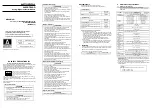
Preparing for Use
R&S
®
ZVA-Z75, -Z90, -Z110, -Z140, -Z170, -Z220, -Z325, -Z500
11
Quick Start Guide 1307.7039.62 ─ 10
2. Check the shipment against the list of accessories to ensure that all items are
included.
3. Remove the protective cap from the test port adapter at the front of the instrument
and carefully inspect the frequency converter to make sure that it was not dam-
aged during shipment.
Should the converter be damaged, immediately notify the forwarder who shipped the
converter to you and keep the container and packing material.
Equipment returned or sent in for repair should be packed in the original wooden box.
Risk of damaging waveguide flanges
The waveguide flanges of the converter and of the test port adapters must be protec-
ted against mechanical damage. Furthermore the waveguides must be shielded from
dust.
Protect the waveguide flange of the converter by leaving a test port adapter mounted.
When the converter is not in use attach one of the included protective caps to the
adapter. Also attach protective caps to the second test port adapter.
The wooden box should also be kept and used for storage of the instrument and the
accessories.
2.4.2 Setting up the Converter
The frequency converter is designed for use under laboratory conditions on a bench
top. The surface of the bench top should be flat. The converter must be used in hori-
zontal position.
The general ambient conditions required at the operating site are as follows:
●
The ambient temperature must be in the ranges specified for operation and for
compliance with specifications (see data sheet).
●
All ventilation openings must be unobstructed.
Risk of instrument and DUT damage
To avoid damage of electronic components of the DUT and the frequency converter,
the operating site must be protected against electrostatic discharge (ESD).
To prevent ESD damage use the wrist strap and grounding cord supplied with the net-
work analyzer and connect yourself to the GND connector at the front panel of the ana-
lyzer. For details refer to the Quick Start Guide of your analyzer.
Putting the Converter into Operation










































